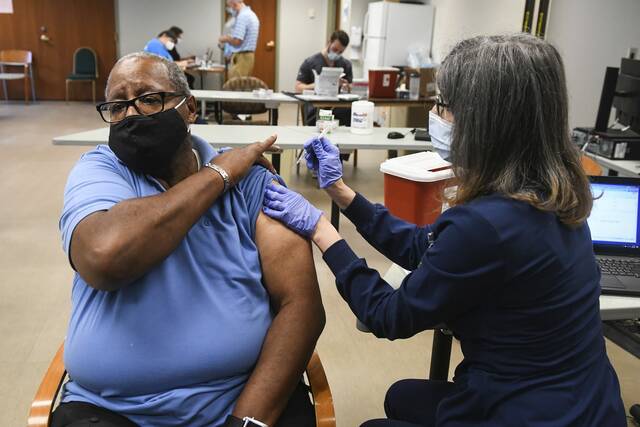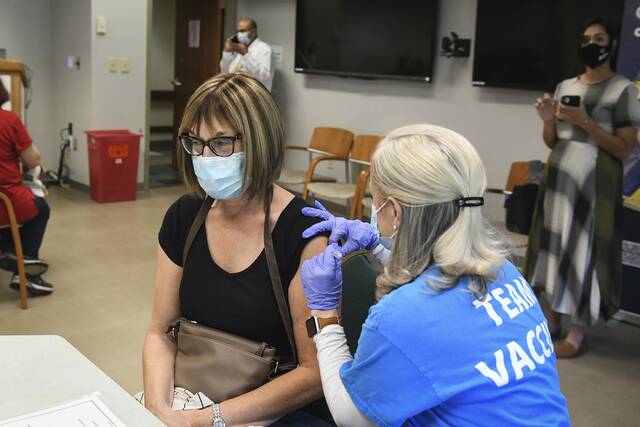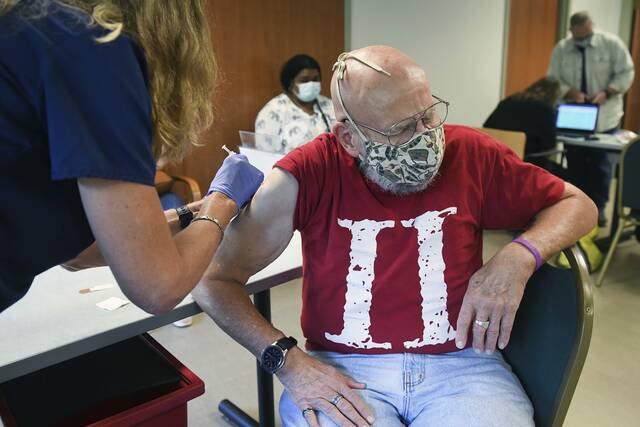Gov. Wolf pushes state lawmakers to boost vaccination rates in their districts
Americans have seen vaccination rates by state, county and ZIP code. Now, as Gov. Tom Wolf’s administration tackles vaccine hesitancy, there’s yet another metric in Pennsylvania.
A new report that breaks down vaccination rates by Pennsylvania legislative district suggests there is a significant rural-urban divide, with the highest vaccination rates in urban and suburban areas and the lowest in rural communities.
Although that divide often lines up with local politics, with the lowest vaccine rates in rural, Republican House and Senate districts, the data show some more affluent urban and suburban Republican districts with high vaccination rates.
The data are based on total census numbers and could be read as a matter of the Democrat governor throwing down the gauntlet to Republicans whose constituents have been slow to embrace the covid-19 vaccine.
While he made no mention of partisan politics, Wolf said his administration released the data in an effort to highlight the importance of the issue to members of the General Assembly in areas lagging behind in vaccination rates.
“It is our hope that this information will help inform members of the General Assembly, stakeholders and community members, to join us in encouraging Pennsylvanians to get vaccinated,” Wolf said.
A national study published this week in the New York Times, headlined “Red Covid,” showed vaccination rates are the highest and death rates are the lowest in areas where Democrats dominated the 2020 presidential race. The converse — lower vaccination and higher death rates — were found in counties that voted Republican.
But the report that looks at Pennsylvania legislative districts shows that residents of affluent state House and Senate districts in Pennsylvania, be they red or blue, have flocked to vaccine clinics.
In the state House, the trend is apparent south of Pittsburgh, where Democrat Dan Miller’s district — including Mt. Lebanon, Scott and Baldwin — is the most vaccinated in the state with 69% of the residents boasting shots. Republican Natalie Mihalek’s nearby district — which includes Upper St. Clair, Bethel Park and McMurray — boasts a 67.3% vaccination rate.
At the other end of the vaccination spectrum, the report shows House Speaker Bryan Cutler’s rural Republican district in Lancaster County with the lowest vaccination rate of any district in the state at 32.2%.
In the Senate, Republican Sen. Judy Ward’s rural central Pennsylvania district posted the lowest vaccination rate with 36%. At the other end of the spectrum, Sen. Devlin Robinson, a Republican whose suburban district includes Upper St. Clair, Robinson, North and South Fayette, Mt. Lebanon and Bethel Park, boasted the highest vaccination rate of any Senate district, at 65.9%.
Noting that the New York Times data suggested vaccination rates lined up with political affinities in the last presidential election, Dr. Amesh Adalja, a Pittsburgh-based infectious disease expert, said it’s not a matter of rural areas with low vaccination rates having escaped severe brushes with the virus.
“I’m from Butler County, and Butler County was No. 2 in terms of outbreaks. (Rural areas) are getting hit hard, and hospitals in rural areas are really getting crushed, versus the urban hospitals that can adjust capacity somewhat,” Adalja said.
Although access to the vaccine was an issue in some rural areas the early days after its approval, that is no longer the case in the U.S.
“People are throwing vaccine away. It’s just that some people are choosing not to get it,” Adalja said.
Whether the new state report will have an impact on vaccine resistance or hesitancy is questionable, he said.
“It’s getting very difficult because some of these people are very dug in,” Adalja said. “You have to try and meet them where they are and find out what’s holding them back and reinforce how important it is in preventing disease and the serious effects of disease.”
Wolf said that is what his administration is stressing in these new reports, even as some local lawmakers battle mask mandates and endorse personal choice over urging further vaccination pushes.
“The overwhelming majority of the covid-19 related cases, hospitalizations and deaths in Pennsylvania occurred in people who were not vaccinated,” Wolf said. “In fact, the data shows that compared to unvaccinated people, fully vaccinated folks are seven times less likely to get covid-19, and eight times less likely to die from covid-19. We urge all Pennsylvanians who are not yet vaccinated to get their shot today.”
Deb Erdley is a Tribune-Review staff writer. You can contact Deb at derdley@triblive.com.
Remove the ads from your TribLIVE reading experience but still support the journalists who create the content with TribLIVE Ad-Free.





